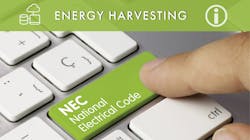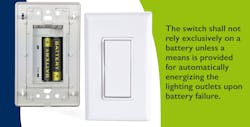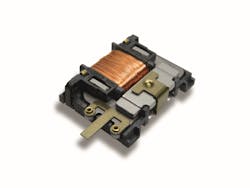CONTROLS | Energy-harvesting light switch technology meets 2023 NEC specification
Adopted in all 50 states, the National Fire Protection Association (NFPA) 70: National Electrical Code (NEC) is the country’s benchmark for safe electrical design, installation, and inspection to protect people and property from electrical hazards in residential, commercial, and industrial settings. It was first published in 1897 as a response to the high risk of fire hazard in the early days of electrification and the need for fire insurance criteria. This set of standards and guidelines informs electricians and individuals opting for a DIY approach of installation, operation, and maintenance procedures in alignment with fire insurance requirements. Updated every three years, the NEC is recognized by the American National Standards Institute (ANSI) and comparable to other international standards, such as the German DIN VDE 0100 norm.
Infringement of the NEC comes with the risk for consequences. For example, a homeowner could face penalties or lack of insurability for DIY installation of noncompliant devices that result in an electrical hazard. Although the NEC is not federal law and thus not directly enforceable by the federal government, it is adopted by state and local governments that enforce compliance through building codes and inspections. As a result, requirements and enforcement mechanisms vary by location.
The 2023 NEC adds new measures to ensure safety if a battery fails in a switch or wall-mounted control device in Section 210.70 Lighting Outlets Required, which applies primarily to dwelling spaces, including habitable rooms, kitchens, bathrooms, toilets, laundry areas, basements, attics, utility areas, and garages, as well as hospitality facilities and student accommodations. Specifically it states, “Lighting outlets shall be installed where specified in 210.70(A), (B), and (C). The switch or wall-mounted control device shall not rely exclusively on a battery unless a means is provided for automatically energizing the lighting outlets upon battery failure.”
The failure of a battery in a wall-mounted control device serving required lighting outlets should not prevent the safe egress of a habitable room, attic, or basement. Having utility power present with no way to energize the lights due to a bad wireless switch battery is hazardous to occupants.
In practice, this standard prescribes any wall-mounted switch or control device for room lighting to be permanently connected to a constant power supply — even if the switch is principally battery-powered and governs an appliance wirelessly or has an override backup solution in the system, such as a line-powered occupancy sensor to ensure lighting outlets are energized in the case of switch battery failure.
This effectively requires extra wiring — though wiring inherently constitutes a potential fire hazard in itself. According to the NFPA, “Electrical distribution or lighting equipment is the third-leading cause of home fires, and the fourth-leading cause of home fire deaths. Conditions that make these fires possible can occur long before a fire presents — largely as a result of wiring being installed or repaired incorrectly, or when receptacles, power strips or cords are overloaded, etc.”
In practice, the implementation of the 2023 NEC 210.70 requirements obsoletes the majority of today’s battery-powered wireless switches utilizing Bluetooth, Zigbee, Z-Wave, LoRa, or proprietary wireless technology as stand-alone devices due to their lack of backup AC power.
Mechanical energy harvesting
As an alternative to pulling additional cables or installing additional devices to lighting systems to make them NEC 210.70 compliant, owners can use energy harvesting to power switches and wall-mounted devices. Mechanical energy harvesting has been used for decades in multiple ways, such as bicycle dynamos that power lights by harvesting energy through the motion of the wheels, or a watch that charges itself through the motion of the wearer’s wrist during everyday use.
Similarly, miniature electromagnetic energy harvesters have been used in automation systems over the past two decades. The act of pushing a button or walking across a floor creates mechanical energy, which is then converted to electrical energy to power electronic devices.
A magnet moving axially through the center of a coil will induce a voltage across the coil terminals. One practical application occurs in shaker flashlights that one can vigorously shake back and forth, causing a magnet to move through a multiturn coil, which ultimately provides charge to the battery.
In automation systems that send control or monitoring signals, turning a door or window handle can send a signal to alert security or to activate/deactivate lighting and HVAC systems. Similarly, the energy harvested through pushing, pressing, and releasing a switch can feed an ultralow-powered wireless module, telling a light to switch on or off, or to dim up or down. Electronics have improved to the point that an energy harvester can be sized to fit into a standard format switch or handle while creating enough energy — 120µW — to send multiple signals at every use.
International Open Wireless Standard ISO/IEC 14543-3-10 (Europe) and 14543-3-11
In 2012, the International Organization for Standardization and the International Electrotechnical Commission created and released the internationally standardized ISO/IEC 14543-3-10/11 wireless protocol, which is similar to wireless standards such as Wi-Fi and Bluetooth. It is optimized for wireless solutions with low energy needs that can be supplied primarily by energy harvesting.
To minimize the energy consumption and interference potential while maximizing indoor range, the minimum telegram length sent is only about 1 millisecond at a data rate of 125kbit/sec at 902MHz. The telegrams are repeated several times within 40 milliseconds, avoiding collisions of telegrams and numerous switches, and many sensors can be operated in parallel without any problems. Each radio module, such as a switch or controller, has a 32-bit unique identification number. The radio range is up to 1,000 feet in open spaces and about 100 feet in buildings. These radio waves can easily penetrate walls and offer robust transmission power. At the same time, the high-frequency radiation is 100 times lower than in classic wired solutions.
Global standard support
The EnOcean Alliance, a nonprofit educational organization founded in 2008 that has more than 400 member companies, enables a multivendor ecosystem based on the ISO/IEC 14543-3-10/11 wireless standard. As a promoter of this global standard, this open organization is committed to enabling interoperable ecosystems for smart homes, buildings, and spaces based on the maintenance-free radio standard. As a result, building owners can deploy products from different manufacturers in one system because the devices all speak the same standardized language. Currently, dozens of manufacturers offer such energy-harvesting light switches that follow the standard.
Energy-harvesting switches and wall-mounted devices are a smart way to comply with the new NEC requirements. They also reduce the fire risk from bad wiring; decrease carbon footprint, thanks to reduced materials usage; and lower maintenance by eliminating battery changes.
GRAHAM MARTIN, a veteran of the electronics industry with years of experience in analog and RF solutions, initiated the EnOcean Alliance in 2008. As chairman and CEO, he is responsible for the strategy and development of the international consortium.
Follow our LinkedIn page for our latest news updates, contributed articles, and commentary, and our Facebook page for events announcements and more. You can also find us on the X platform.

Graham Martin
GRAHAM MARTIN, a veteran of the electronics industry with years of experience in analog and RF solutions, initiated the EnOcean Alliance in 2008. As chairman and CEO, he is responsible for the strategy and development of the international consortium. The EnOcean Alliance unites leading companies in the building and IT industries. The open, non-profit organization is committed to enabling and promoting interoperable eco-systems for intelligent buildings, smart homes and IoT based on the wireless, maintenance-free standard ISO/IEC 14543-3-10/11.
Martin studied in the U.S. and Britain, and graduated in physics at Edinburgh University, Scotland.








![The DesignLights Consortium continues to make progress in shifting outdoor lighting products and implementation practices toward a more restrained and thoughtful strategy. [Image does not represent a DLC qualified fixture.] The DesignLights Consortium continues to make progress in shifting outdoor lighting products and implementation practices toward a more restrained and thoughtful strategy. [Image does not represent a DLC qualified fixture.]](https://img.ledsmagazine.com/files/base/ebm/leds/image/2024/08/66be810888ae93f656446f61-dreamstime_m_265700653.png?auto=format,compress&fit=&q=45&h=139&height=139&w=250&width=250)